Autonomous public transportation isn’t “the future” any more in Sun City, Arizona — it’s already delivering on-demand rides inside the sprawling senior community.
A joint effort by autonomous transportation companies May Mobility and Via (along with AARP sponsorship, per Axios), the Valley wAVe service is currently two self-driving Toyota Sienna vans. Rides are free for residents, and they can be hailed via an app or scheduled with a call between 7 am and 5 pm, Monday through Friday.
Valley wAVe is part of May’s stated goal of making autonomous public transportation available to as many people as possible.
“Having inclusive, accessible transportation is very important in general. We know that it impacts people’s quality of life,” Daisy Wall, director of government business at May Mobility, told Axios. “So we’re making sure [autonomous vehicle] innovation becomes part of overall transportation in a way that’s very inclusive.”
Free, on-demand rides in autonomous and accessible vehicles are now being offered in Sun City.
A sunset city: Opened in 1960 — it’s almost reached retirement age! — Sun City was designed from the ground-up as an active living community for adults ages 55 and older. Dotted with recreation centers, golf courses, and other amenities, the community is meant to be fairly self-contained, with shopping, places of worship, and its own hospital.
The community’s unique population has unique mobility needs and challenges, leading to gaps in the typical systems that autonomous public transportation may be able to fill.
“I only have an electric golf cart, so my travel range is limited,” Sun City resident “Elizabeth” is quoted as saying on May’s site. “My mobility has diminished, especially in the last two years. I gave up my car last year.”
A similar, larger service opened earlier in Grand Rapids, Minnesota, has found success working with older clients and those with disabilities; over half of the riders are 60 or over, with a quarter using wheelchairs, Wall told Axios.
The 11-stop route includes sundry rec centers, a shopping mall, and Banner Boswell Medical Center.
Catch the wAVe: Valley wAVe currently has a two-van fleet of self-driving Siennas, one of which is equipped with a wheelchair ramp, Axios reports.
Their 11-stop route includes sundry rec centers, a shopping mall, and Banner Boswell Medical Center. Unlike a bus, wAVe cars will take riders directly to their chosen destinations, unless it’s picking up others heading to the same place along the way.
While being able to book rides via phone call is an important accessibility option, older customers in other cities have taken to the apps, Dillon Twombly, Via’s chief revenue officer, told Axios, because it allows them to track when the car will arrive.
They may be self-driving, but the service includes a person to monitor the vehicles, assist with any possible accessibility issues, and answer questions, Axios reported.
Other municipalities in the Valley of the Sun have taken a shine to the idea of autonomous public transportation, Wall told Axios; she hopes success in Sun City will pave the way to more routes in the desert.
We’d love to hear from you! If you have a comment about this article or if you have a tip for a future Freethink story, please email us at tips@freethink.com.
